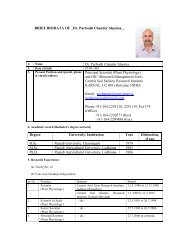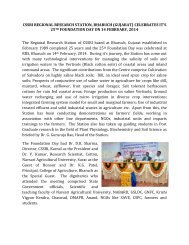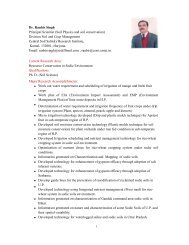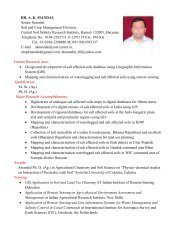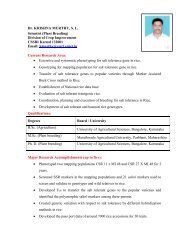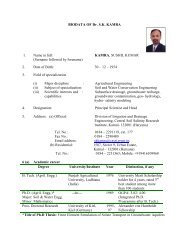Salinity News - CSSRI Karnal
Salinity News - CSSRI Karnal
Salinity News - CSSRI Karnal
You also want an ePaper? Increase the reach of your titles
YUMPU automatically turns print PDFs into web optimized ePapers that Google loves.
SALINITY <strong>News</strong><br />
Vol. 16, No. 2 July-December, 2010<br />
administrative and supporting staff retired from service after rendering<br />
valuable service to the institute. We wish them happy and healthy retired<br />
life. During this period, four scientists of the institute were honoured with<br />
fellowship and gold medal. I congratulate them and wish them all the best<br />
for their future advancement. A number of distinguished visitors visited the<br />
institute. Various extension activities like kisan mela/training programmes<br />
were organized. I believe that the information contained in the newsletter<br />
would be quite useful to our readers and I welcome suggestions/comments<br />
to further improve the contents of the newsletter.<br />
D.K.Sharma<br />
Director<br />
Decision Support System (DSS) for Enhancing Productivity in Irrigated Saline Environment using Remote Sensing,<br />
Modelling and GIS<br />
An irri-agro informatics database of the Western Yamuna Canal<br />
(WYC) command (Fig.1) was created from the authentic secondary<br />
sources maps obtained from various departments/organizations.<br />
The command database includes canal network with discharge data,<br />
digital elevation model, soils, rainfall, cropping system, groundwater<br />
quality, soil salinity and waterlogging, land use and land cover, rail<br />
and road networks, socio-economic data and canal water users’<br />
information. The database was updated with remotely sensed inputs<br />
and was further used for identification and delineation of areas of low<br />
productivity in the command. AquaCrop, ClimGen and CROPWAT<br />
models were calibrated for wheat crop to estimate the current and<br />
future crop water requirement (CWR) under various scenarios to be<br />
used in DSS development. The salt budgeting in the crop root zone<br />
for the wheat crop was also estimated. Three distributaries- Butana,<br />
Gangesar and Kahnaur located within the area of low productivity<br />
in Sonipat and Rohtak districts were selected for DSS validation for<br />
head, middle and tail reach data.<br />
Eight best management practices (BMPs)-conjunctive use of multiquality<br />
irrigation waters, choice of salt tolerant varieties, sowing method (line<br />
sowing versus broadcasting), zero tillage, use of alkali water with gypsum<br />
bed, optimum irrigation scheduling, water application mode and adoption<br />
of low water requirement crops are being demonstrated in farmers’ fi elds<br />
in low productivity area located at the mid and tail reaches. A system<br />
architecture of DSS interface for the Western Yamuna canal command<br />
was developed using Microsoft Visual C#.NET for integrating databases,<br />
models, GIS and spatial query logic. The DSS comprises the following<br />
Field and pot experiments were conducted at Bharuch (Gujarat) with<br />
cowpea, cluster bean, amaranth and lady’s fi nger to ascertain the response<br />
of biological sludge alone and in combination with organic manures viz;<br />
farm yard manure (FYM) and vermicompost (VC) in vegetable crops viz;<br />
spinach, amaranth, cowpea and cluster bean. The leaf yield of spinach<br />
obtained with two cuts indicated that biological sludge applied along with<br />
NPK resulted in enhanced leaf yield, suggesting its effi cacy in providing<br />
additional nutrient availability<br />
to the crop. The plots treated<br />
with biological sludge showed<br />
signifi cant variation with other<br />
treatments except full dose<br />
of vermi compost treatment,<br />
suggesting biological sludge<br />
to be alternative nutrient<br />
source for leafy vegetables.<br />
However, in amaranth the<br />
Fig. 1: An irri-agro informatics database of the Western Yamuna Canal Command<br />
modules and sub-modules- canals, crops, soils, ET, rainfall sub-modules<br />
under crop water demand module, demand-supply gap, groundwater,<br />
Irrigation scheduling, modelling, resource constraints, socio-economic<br />
limitations, BMP based strategies, input availability and providers. Three<br />
modules- crop water demand, demand-supply gap and groundwater are<br />
completed. One hundred twenty stakeholders from state fi eld offi cers,<br />
water users associations’ members and farmers were sensitized to DSS<br />
generated BMPs under uncertain canal water supply and ongoing soil<br />
salinization and waterlogging.<br />
D.S.Bundela, S.K.Gupta, Madhurma Sethi, N.P.S.Yaduvanshi, R.L.Meena<br />
and R.S.Tripathi<br />
Biosludge from the Fertilizer Plant- A Good Alternate Manurial Source for Vegetables<br />
biological sludge applied in combination with NPK and/or FYM/Vermi<br />
compost gave higher leaf yield suggesting the additive effect of these<br />
manure sources. Application of biological sludge in combination with NPK<br />
and vermi compost resulted in increased pod number and number of seeds<br />
per pod in cowpea, when compared to Control (NPK alone). Field study<br />
was conducted on cluster bean with biological sludge and vermi compost<br />
given @ 2 t/ha along with<br />
NPK. Pod length and pod<br />
yield were found to be higher<br />
under Biological sludge given<br />
in combination with organic<br />
manure (vermi compost) and<br />
NPK. Cluster bean, being a<br />
leguminous crop, responded<br />
to nitrogen rich NPK and<br />
Vermi compost.<br />
Soil samples collected<br />
2





